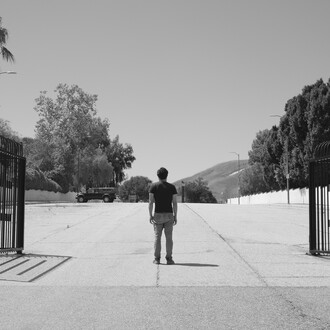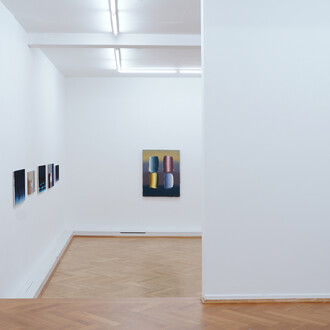Whereas much art – even when maintaining relationships with the world of science – often manifests itself through realizations and works in continuity with an idea of representation carried out in pictorial and volumetric dimensions (opting for an effect of scenic spectacularity), in contrast, the sculptural thinking of Alessandro Sciaraffa is revealed in an “enlarged” conception of space that is in essence experiential, effected well beyond traditional relationships of form, color, and material, entering rather into an “expanded” dimension of the spheres of physical experience where vibrations, magnetic waves, and light itself are the principle fields of observation and the parameters under investigation, articulated in a wide-ranging exploration.
Beyond the optical and kinetic dimension, the more complex and infra-subtle reality of radio signals, the dynamic forces that distinguish the many forms of emission and transmission, find countless possibilities of application in the capacity of light and electromagnetic waves to create and articulate movement, resulting in a wide array of sensations that range from subtle games of illusion to concrete experiences of perceptual transformation.
The desire to work with a similar “expanded” conception of experiential space presupposes a broader idea of movement (that is, one that is able to enter into a more direct relationship with space-time), an approach that seeks and succeeds in manifesting itself through media of great potentiality – light and waves, first and foremost – as a function of a perception that extends beyond the horizon (and the domain) of the merely “material”. In this case, artistic research is oriented in the direction of liberating the work, on a symbolic as much as physical level, also going beyond the dimension of experience of more simple optical and light phenomena, to attempt to restore that enigmatic, unpredictable mutability that characterizes and transforms the universe of things beyond that which is fixed and motionless, toward a dynamic dimension, a universe of variables and of continuous transformation.
Perhaps it is in the research of a “fourth dimension” (which we will define as such, here and now, for the sake of convenience) – where each research contributes to the possibility of testimony not only of a specific interest in a representation of a movement that could correspond to the physical change of position and to the transformation of the psychological condition induced in the direct observer (and user) of such systems – where the continuous process activated by the artist is realized.
Identifying a field of extraordinary scope and a wealth of conceptual convergences and interpretative potential in his research on the reality of sound – sound in its broader meaning of inclusiveness (given the extreme variety and articulation that the acoustic waves’ frequencies involve), Sciaraffa is dedicated to exploring a body of physical characteristics that are essential and fundamental to the physical phenomenon of sound, namely, the exploration of the phenomenon of vibration, certainly a manifestation that is not only part of the truly “physical” universe, but which extends to other dimensions, including the perceptual, certainly, and the psycho-acoustic.
From an impulse already shown in works strongly marked by a performative dimension (Shaping the Shadow, 2009 – the vast sculpture which, with its bi-dimensional presence, once animated and set in motion and amplified with contact microphones, assumes monumental proportions – or Ti porto il mare [I’ll bring you to the sea], 2010 – the sonic landscape implemented and “propagated” in a suggestive installation of rolling drums containing sand, suspended along a grid of steel cables), an option that the Turin artist always seems to put into play is a real willingness to make himself both subject and object of his research. The interaction between forms that initially are just sculptural (in their potential state) and their (subsequent) sonic realization surpasses and transcends the simple level of relationship and of direct, consequential connection, breaking open a perceptual leap that certainly renders it more surprising, not so much because of the imaginary ability as the transformative nature of our most concealed sense, namely, that of hearing.
If the well-chosen critical formula of a research of “emancipation from the conditioning of images that influence and preordain the emotions of each individual” (as correctly defined by D. Trincia) was coined, it is because a significant leap is activated toward a more interior dimension, a deeper sense of hearing that is loaded with broader interpretative margins. More recently, in fact, in the construction and arrangement of vast “wall flowers”, new works intended for an installation mounted on walls – through complex circuits of composite material– the artist sets into action the vision and experience of possible trajectories where the impulses of the electric power continuously flow through geometric-sculptural models: the tension and intensity of the electric current thus reveals itself in the material, acoustic manifestation of vibrations and carefully calibrated sounds, resulting in the accurate selection of small cymbals and resonant discs that comprise the articulated sculpture.
More recently, Sciaraffa carried out an articulated project – in several phases – dedicated to the resonance and influence that the moon seems to project over our perception and imagination.
An extensive series of works prepare and accompany the leap involved in the solo exhibition of 2014 (“Lunatics speak to the moon”). From the prints of Tattoo Moon – or by way of a series of tambourines imprinted with the image of the moon – tatooed forms on natural skins (directly by lunar light) – this is how one approaches a synaesthetic listening and describes those forces that the celestial body seems to emit: desiring to absorb with the skin, the moon brings us back to a dimension that is almost ancestral, where the actual gigantic distance is shortened and materializes in the presence of the impression of forms on organic material, almost as marked by an astrological sign.
Proceeding to an all-round observation, there are yet other works – fundamental passages – that articulate a dialogue between our globe of land and water and the majestic lunar atmosphere: traces that unequivocally emerge from the impression of lunar rays (directly recovered from the eyepiece of an optical telescope – such as in Catturare il riflesso della Luna in un assolo di chitarra elettrica [Capture the reflection of the moon in an electric guitar solo] – 2012) in lunar images directly exposed on silver-coated paper, until the dark face of the moon appears and disappears – its presence engraved on plates of glass varnished with liquid crystal in black which – depending upon the prevailing temperature (between 25°-30° C) – become transparent (in Cool Moon), allowing the hidden face of the moon to emerge, engraved on the opposite side of the glass.
It is with the vast project of I lunatici (2014), in which Sciaraffa arrives at imagining and materializing an exchange between terrestrial and celestial dimensions by strengthening the possibilities of the means of radio transmission. Thanks to signals collected by a microphone placed in the middle of the exhibition space and by means of the gallery’s streaming connection, the radio data broadcast (via radio telescope) transmits selected signals in the direction of the moon. Given the power of the microwaves that are used, the sounds thus travel and bounce back toward earth, covering a distance of 768,800 km in just two and a half seconds… a span of time, at once minimal and immense, that manifests and gives substance to a sense of leaping, of emptiness that is a tangible force, almost the materialization of the far-away distance that our comprehension has of the interval of time and space between spatial realities still separate.
Thus, in this way, the moon becomes a kind of immense musical instrument and mirror, capable of recreating new sounds: its well-known ability to reflect the light of the sun seems to have stimulated the imagination of the artist, who utilizes the wide spectrum of sounds collected from the audience during the participatory performance (songs, words, conversations, voices, performed melodies, to name a few…) in order to achieve a complete redefinition of the possible relationship between terrestrial presences and heavenly bodies. In establishing a hypothesis of the possible relationship, a sort of communication process with the vast resonant material of a planet, the moon now aspires to become a paradigm of mirroring – an immense basin of projection that is able to return to us a body of sounds that, among echoes, reflections, delays, reverberations, and resonances, are the materialization of a dream perhaps as ancient as humanity - to rediscover a “kindred” presence.















